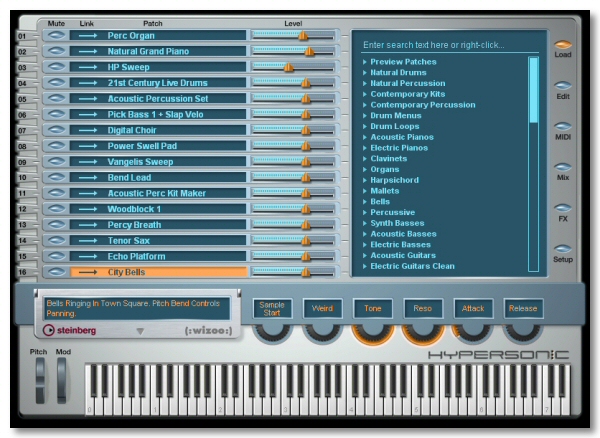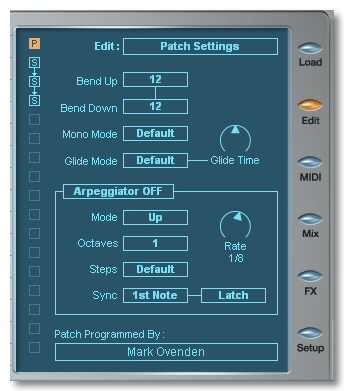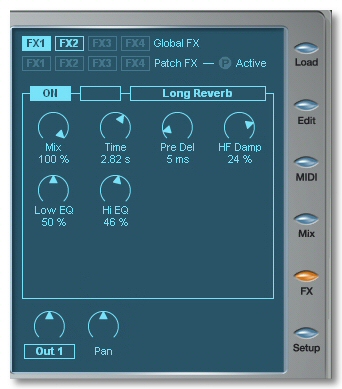HyperSonic - The Sound Barrier ?

This article was first written for Keyboards / Home Studio magazine. It is published here with their kind autorization, thanks ,o))
According to the presentation on Steinberg-France's website, HyperSonic is an " amazing tool for song writers under the appearance of an extensible and professional workstation ". A new success of Steinberg / Wizoo duet or just a marketing concept ?
Behind this introduction is hidden thus the last born from Steinberg's, a VST Instrument supposed to replace the good big old hardware workstations and having the ambition to propose to the musician a large choice of quality-made sounds, many effects, some editing possibilities, all of that with a reduced CPU / RAM use.
Hyper concise introduction
The package is faithful with Steinberg's habits (we won't get worried about this), that is to say that it contains a CD (that's better !), a very well-made paper manual in French, the register card and an USB device key, you will have to do with it now. If you possess already such a key for Cubase or Nuendo, you will able to use it to authorize HyperSonic. For the remainder, the installation is very classical with, as it is more and more often practiced, a distinct choice of the destination folder for the program and for the sound files.
Hyper simple

The interface is very readable, not very very beautiful but neither not so awful
and it very simple and pleasant at use. Restful is the suitable term.
HyperSonic is very childish at use. As early as you start for the first time, you
feel yourself at home. On the left side, 16 slots corresponding to the 16 Midi channels
(knowing that several slots can be linked and use the same channel)
and where you can load some Patches to keep among the 1000 ones
furnished in the box " Display " at right when it is in " Load " mode. Each sound can be muted, but a solo function would have been welcome.
Between those two boxes, 16 faders acting by default on the Midi volume
but being able to control also velocity, polyphony or Audio volume. Below the Patches list, a small window " Hyper Display " gives a precise description
of the selected sound, description which can be modified.
Under the Hyper Display are hidden the five extension slots provided for
adding to the program, in the future, either some synthesis modes, or some
supplementary soundbanks.  On the right side, come 6 buttons rather original, the " Hyper-potentiometers ". According to the selected
Patch, the parameters of the 6
buttons vary for a quick edit of the sound. For a lead guitar,
you will have for example Attack Shape, Color, Tone, Eq, Amp Select and
Overdrive. For a string ensemble, you will have Panner, Richness, Tone,
Reso, Attack and Release. For certain drum kits, you will be able to
choose the sample, even if I've noticed this doesn't always
function. Mainly, the adjustments, which are imposed and fixed,
are rather well choosen and their names are logical, in condition that
English wouldn't be irrelevant to you. Thanks to those 6 adjustements,
Hypersonic succeeds in decaying a same basic sound into several versions
to achieve the magical number of 1000. To be noted that the Hyper-potentiometers can be controlled via Midi.
On the right side, come 6 buttons rather original, the " Hyper-potentiometers ". According to the selected
Patch, the parameters of the 6
buttons vary for a quick edit of the sound. For a lead guitar,
you will have for example Attack Shape, Color, Tone, Eq, Amp Select and
Overdrive. For a string ensemble, you will have Panner, Richness, Tone,
Reso, Attack and Release. For certain drum kits, you will be able to
choose the sample, even if I've noticed this doesn't always
function. Mainly, the adjustments, which are imposed and fixed,
are rather well choosen and their names are logical, in condition that
English wouldn't be irrelevant to you. Thanks to those 6 adjustements,
Hypersonic succeeds in decaying a same basic sound into several versions
to achieve the magical number of 1000. To be noted that the Hyper-potentiometers can be controlled via Midi.
At the bottom of the interface is located the classical 88 keys keyboard sensible to
the velocity. Nothing more to say.
At the top of the Display, there is a search engine in order to go through among the
available sounds. Enter " Piano " and choose the one which is best convenient to you.
The search engine is supposed to take in account the commentaries displayed
in the Hyper
Display, zone, but it does this only for the user Patches utilisateur.
It is a little bit strange since it is possible to
annotate a factory Patch. Well...
Hyper modest Editing
 Although HyperSonic have before all the ambition to furnish to you some sounds to
be used immediately, it proposes even so some editing possibilities. When
switching to " Edit "
mode in the Display, you visualize the structure of a Patch.
Although HyperSonic have before all the ambition to furnish to you some sounds to
be used immediately, it proposes even so some editing possibilities. When
switching to " Edit "
mode in the Display, you visualize the structure of a Patch.
A sound is built from the 5 synthesis modes of which is capable the
software, modes with evocative names : multisample, analogic synthesis,
FM synthesis, wavetable synthesis and "Sliced Wave Loop" synthesis, a
sound being able to use several ones. The structure can also contain some
effects. It is not possible to build a sound entirely yourself, you must
start from an existing Patch and modify it, however without being able to
interfere on its structure (except the fact of being able to deactivate the
elements separately).
Selecting an element for editing makes its own parameters appearing.
For the sound elements, you will have access among other things to the
chord, to a rather complete filter with its 5 points ADSR envelop, to its
5 points amplitude envelop too, then to the volume, pan, velocity
and polyphony. The minimum vital thus, but it does its job well.
Don't forget that you don't have under the mouse neither a sampler nor
a synth, but a sound box ready at use.  A rather curious thing about ergonomy. The value of a parameter
is displayed either below the fader managing it, or in the Hyper Display, obliging thus your eyes to move permanently from a point to an other one
in the interface.
A rather curious thing about ergonomy. The value of a parameter
is displayed either below the fader managing it, or in the Hyper Display, obliging thus your eyes to move permanently from a point to an other one
in the interface.
If you have business with an effect element, the adjustments will vary of course
depending of its nature. The effects are to be choosen among the forty ones
proposed : reverbs, delays, modulation, eq, dynamics,
overdrive, etc. The effects do their job and the proposed settings are
appropriated. To be noted that an effect output can be routed towards the Audio
output of your choice with Pan adjustment, well done !
A
Patch has got also its global parameters like the Bend, the Mono mode, the
Glide and a little arppegiator. At least, you have at disposal some vital adjustments
for each sound, not enough to become a Sound Designer, but it is not really
the aim ,o)
The " Midi " page of the Display
allows to choose the range of the keyboard
covered by a Patch, with possibility of split and crossfade
between each zone. You can find also the usual "Velocity
Range" adjustment, very useful to play a sound rather than an other one depending
of the velocity.
In the " FX " page you will be able to load 8 effects (4 Sends, 4
Inserts) to be choosen among the 40 quoted previously. The effect starting level
is managed in the " Mix " page where you can find a main pan too
and the choice of the Audio output, 32 stereo ones at maximum, example, 1 stereo
per Patch, that is the ideal. On an other hand, the faders are a little bit hard
to manipulate through this page.
There is just the page " Setup " left to talk about. It proposes a few
main adjustments like the activation of the Audio outputs (you must then
launch again the plug !), the activation of the reception of the Program Change or
more over the main adjustments of volume, velocity and Aftertouch.
You will notice that I skilfully avoided to talk about the essential, the sound !
I kept this for the end because there are much things to say...
Hyper sounds ?
Before all, let's talk about technique. It is announced that the program is a few
greedy in CPU and in RAM. This is quite true. A " Grand Piano "
uses only 6,2 MB of memory. To succed in such savings, two
tricks were used : compression, of course. It is promised without
sound quality loss, but since we don't have at disposal the primary samples,
it is not possible to judge. 2nd finding : if a sample is used by
several Patches, it is loaded only once in memory. Simple,
but efficient.
At least, the demo song " Deep Rock ", using 16 Patches and many
internal effects, consums only 11 MB of memory and from 30 to 35 % of
my PIV 2,8 GHz.
It is important to keep those parameters in mind because it is
evident that a piano based on 6 MB of compressed samples can't
compete in any case with a 1 GB bank loaded in a sampler for example.
Same thing for a 7.3 MB HyperSonic drum in comparison with a 300 MB
LM4 bank with 8 or 10 samples per drum element.
All of this in order to say that wonders don't exist ;o) The sounds quality
delivered by HyperSonic is exactely the one you could wait for from a
Workstation. They are made of very good quality in comparison with a "real"
workstation but quite ordinary in comparison with some specific
soundbanks. Among the sounds which come off, I was surprised by
the acoustic and electric pianos, the synthetic sounds are mainly
efficient, the "Brass Sections", the saxes, the
Harpsichords pull through pretty well, as well as for the Pad sounds.
Cope fairly the drums (the crashes cruely miss of definition),
the electric basses, very particular, and the background strings.
The latters, like it is often the case on the
Workstations, are the guitars, the solo wind instruments, and much
surprising, the organs.
The Patches can be grouped into Combis (combination of 2
up to 16 Patches). By routing each Combi's Patch towards the same Midi
output, it is possible to obtain some very rich sounds which can vary, depending of
the velocity and the played range of the keyboard. The released Combis are very
interesting and representative of the possibilities of the program in this type
of configuration.
So, all not nice ? Of course not. You just need to be agree with
the use which can be done with this software. To my own, it can quite be used
as a work basis for the musician suddenly inspired ! You launch HyperSonic
and you have immediately at your disposal almost all that you need
in sound term. A GM mode would have been welcome however. Once the
writing stage is finished, it will be thus, maybe, time to go to
search for some killing sounds if some
Patches don't meet the case.
Another possible use : on a little notebook during a travel
(let's recall that the few requested ressources allow to use Hypersonic
on a little configuration). Are you inspired an evening when alone at the hotel ? (note of the translator :
are U talking to me ??? ;o) Launch HyperSonic and put down the basis of your future chart !
In short, if you need a good little bank of 1000 sounds always
available sans se prendre la tête, if you travel with your portable,
Hypersonic vous rendra de grands services. On an other hand, if you search for
high quality-made sounds, rather look for a sampler solution added
dedicated soundbanks, but the billnote won't be the same.
Talking about price, you could find HyperSonic expensive for a VSTi, one
more time it will be convenient to remind you the price of its hardware
equivalent...
See ya soon, here or somewhere else ,o)
-
Pros : easiness of use and editing, the few ressources requested, the extension slots which offer a future to the software, the 32 Audio outputs
-
Cons : the relative quality of some sounds, no GM mode, no Solo mode for the Patches, ergonomy sometimes a little bit strange
- Sound : 15/20
- Ergonomy : 17/20
- Quality/Price rate : 16/20
Description
- Name : HyperSonic
- Type : Workstation type VST Instrument
- 1000 Patches, 100 Combis, 70 drumkits, 2560 user programs
- 5 synthesis engines
- Multitimbral 16 channels per instance
- Polyphony : 1024 voices per instance
- 32 audio channels in output, adjustable (Quad, Stereo, Mono)
- Editor : Steinberg http://www.steinberg.net
- Distributor : http://www.steinberg.fr
- Mainly noticed price : 400 €uro
Suggested Configurations
-
PC : PIII 500 MHz or AMD K7/P 4 or Athlon 1 GHz, 256 MB of free RAM, 300 MB of free disk space, display card 1024 X 768, VST 2 compatible hosting, Windows 2000/XP, soundcard MME or ASIO (ASIO recommandé), a free USB port
-
MAC : G3/G4 500 MHz, 256 MB of free, 300 MB of free disk space, Mac OS 10.2 or higher, VST 2 compatible hosting, display card 1024 X 768, free USB port, soundcard with ASIO driverPascal VALENTIN, on the 10-01-2004
 Page viewed 14648 times
Page viewed 14648 times




